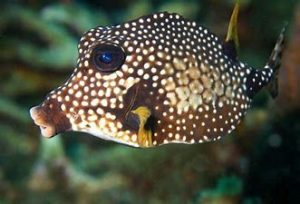
Trunkfish
Trunkfish are interesting marine fish known for their box-like shape and unique defense mechanisms. Here are some facts about trunkfish:
Appearance: Trunkfish have a distinctive box-shaped body covered in hard, bony plates called scutes. The scutes give them a rigid appearance and provide protection. They have small, pucker-like mouths and eyes located on the sides of their bodies. Trunkfish come in a variety of colors, including yellow, blue, brown, and black, often adorned with intricate patterns.
Defense Mechanism: Trunkfish have a remarkable defense mechanism to protect themselves from predators. When threatened, they can release a toxin called ostracitoxin from special glands in their skin. The toxin is poisonous and acts as a deterrent to potential predators, making them think twice before attacking. The toxin can also have a harmful effect on other fish and invertebrates in close proximity.
Puffer Capability: Trunkfish belong to the same family (Ostraciidae) as pufferfish. Like pufferfish, trunkfish can inflate their bodies by ingesting water or air. When they do this, their bony plates become more pronounced, increasing their size and making them even more challenging for predators to consume. Inflating also helps them wedge themselves into crevices for protection.
Feeding Habits: Trunkfish are primarily herbivorous, feeding on algae and seagrasses. They have specialized mouth structures designed for grazing on these plant-based food sources. They use their small mouths to pick at algae or scrape the seafloor to unearth seagrass and algae. They play an essential role in the maintenance of healthy coral reef ecosystems by controlling algae growth.
Habitat: Trunkfish are found in tropical and subtropical waters of the Atlantic, Indian, and Pacific Oceans. They prefer shallow, protected areas such as coral reefs, seagrass beds, and lagoons. They can often be seen hovering near the seafloor, searching for food or seeking shelter among coral formations.
Reproduction: Trunkfish reproduce through external fertilization. During spawning, females release eggs into the water column, and males release sperm to fertilize the eggs. After fertilization, the eggs develop into free-floating larvae that eventually settle onto the seafloor and undergo metamorphosis into juvenile trunkfish.
Conservation Status: Trunkfish populations face threats due to habitat degradation, overfishing, and the aquarium trade. Some species of trunkfish are targeted for their unique appearance and are collected for the aquarium trade. It is essential to regulate fishing practices, protect their habitats, and promote sustainable management to ensure their long-term survival.